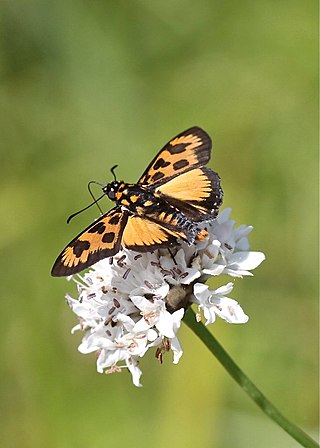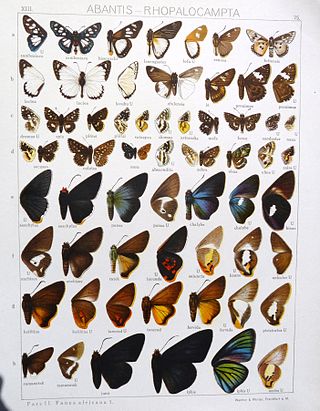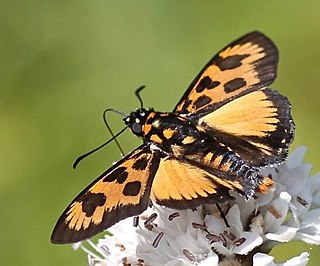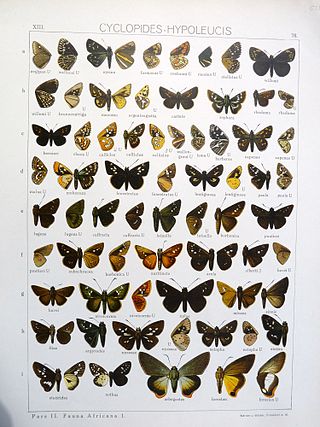
Ornithoptera paradisea, the paradise birdwing, is a species of birdwing butterfly found in New Guinea.
Lepidochrysops littoralis, the coastal blue, is a species of butterfly in the family Lycaenidae. It is endemic to South Africa.
Chrysoritis irene, the Irene's opal, is a species of butterfly in the family Lycaenidae. It is endemic to South Africa, where it is found in fynbos on the Du Toit's Kloof mountains and Rivieronderendberge in the Western Cape.
Thestor dryburghi, the Dryburgh's skolly, is a species of butterfly in the family Lycaenidae. It is endemic to South Africa where it is only known from northern Namaqualand in succulent Karoo-covered hills at Kamieskroon to the north-west of Steinkopf in the North Cape.

Abantis is an Afrotropical genus of skipper butterflies. They are also known as the paradise skippers. Their imagos are generally attractive with bold or colourful wing and/or body markings. They occur in either forest or savanna, and several species are very localized or thinly distributed. The territorial males are encountered more often than the females. Males engage territorial intruders, and are prone to very rapid and high flight, while females display more relaxed flight habits, closer to the ground. Plants of several families serve as food plants, and only one egg is oviposited per plant. The larva is pale and spotted to varying degrees, and pupates inside a leaf shelter drawn together by silk threads.

Eagris nottoana, also known as the rufous-winged flat or rufous-winged elfin, is a species of butterfly in the family Hesperiidae. It is found from South Africa to Uganda, Kenya and Ethiopia, and on Madagascar.

Abantis pillaana, the ragged skipper, is a butterfly of the family Hesperiidae. It is found in South Africa, Zimbabwe, Botswana, from Mozambique to eastern Africa, Ethiopia and south-western Arabia.

Abantis tettensis, the spotted velvet skipper, is a butterfly of the family Hesperiidae. It is found in South-West Africa, Botswana, Transvaal, northern Cape, from Zimbabwe to Zaire and in Kenya.

Abantis bicolor, the bicoloured skipper, is a butterfly of the family Hesperiidae and the subfamily Pyrginae. Described in 1864 and endemic to South Africa, the bicoloured skipper is restricted to lowland forests from the Eastern Cape to the southern and northern coasts of KwaZulu-Natal.

Abantis venosa, the veined skipper or veined paradise skipper, is a butterfly of the family Hesperiidae. It is found in Zululand, Eswatini, Transvaal, Zimbabwe, Kenya and Uganda.

Metisella syrinx, the bamboo sylph or bamboes-walsertjie, is a butterfly of the family Hesperiidae. It is a rare and highly localised species which is only known from South Africa in the eastern Cape, through southern Lesotho to the extreme south of KwaZulu-Natal. The habitat consists of rocky areas on the summits of mountains, in montane grassland.

Parosmodes morantii, the Morant's skipper or Morant's orange, is a butterfly of the family Hesperiidae. It is found in KwaZulu-Natal, Eswatini, Mozambique, Botswana, Zimbabwe and from western Kenya to Ghana.
Aloeides caffrariae, the border copper, is a butterfly of the family Lycaenidae. It is found in South Africa, where it is known from coastal grassland in the Eastern Cape.
Aloeides gowani, the Gowan's copper, is a butterfly of the family Lycaenidae. It is found in South Africa, where it is known from the Western, Eastern and the Northern Cape.

Aloeides taikosama, the dusky copper, is a butterfly of the family Lycaenidae. It is found in South Africa, Botswana, Lesotho, Mozambique and Zimbabwe. In South Africa it is found from the eastern Western Cape to the Eastern Cape, the Free State, northern KwaZulu-Natal, Gauteng, Mpumalanga, Limpopo, North West and the eastern Northern Cape.
Lepidochrysops ignota, the Zulu blue, is a butterfly of the family Lycaenidae. It is found in South Africa, from the KwaZulu-Natal midlands to Eswatini, Mpumalanga, Limpopo and Gauteng.
Lepidochrysops grahami, Graham's blue, is a butterfly of the family Lycaenidae. It is found in South Africa, where it is known from the north-eastern Eastern Cape.
Orachrysops montanus, the Golden Gate blue, is a butterfly of the family Lycaenidae. It is found in South Africa, where it is known from montane grassland in the Golden Gate Highlands.

Charaxes castor, the giant emperor or giant charaxes, is a butterfly of the family Nymphalidae. It is found throughout the Afrotropical realm below the Sahel.

Bridelia micrantha, the mitzeeri or the coastal golden-leaf, is a tree in the family Phyllanthaceae and is native to tropical and southern Africa as well as to the island of Réunion in the Indian Ocean.











